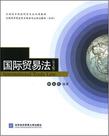国际贸易法
2008-4
对外经济贸易大学出版社
韩永红
344
无
本书的编著遵循“方便使用者”(user-friendly)的指导思想,从体例安排到语言风格均旨在满足使用者(包括教授者与学习者)的实际需求。为帮助使用者快速了解本书,现将其主要特点简要介绍如下: 一、在体例设计上,本书兼采中外同类著作的优点,从方便教学,方便学习者使用的角度设计。全书正文共设十章:国际贸易的法律环境、国际货物买卖法(I)、国际货物买卖法(II)、国际货物运输法律制度、国际贸易支付法律制度、国际技术转让法律制度、国际电子商务法律制度、世界贸易组织法律制度、各国管理贸易的法律制度、国际商事争议解决法律制度。每章包括“内容大纲”、“热身问题”、“正文”、“小结”和“练习”五个组成部分。“内容大纲”(Chapter。outline)可帮助使用者宏观了解本章的内容结构和主要问题,课前对“热身问题”(Warm-up questions)的讨论则可以帮助学习者积累必要的背景知识,激发其学习本章内容的兴趣和探索的热情。“小结”(Chapter summary)是对本章所讨论的主要理论、规则、观点的简要归纳,以帮助学习者回顾本章的主要内容。“练习”(Chapter questions)部分安排了“正误辨析”、“问答题”、“案例题”,个别章节还安排有“选择题”和“开放式讨论题”等多种练习形式,使用者可根据个人情况选择逐一完成或只选做其中部分题目。除上述内容外,全书还包括“前言”、“目录”、“附录”、“法律术语表”、“参考书目”其他五个组成部分。 二、在内容安排上,本书紧扣国际贸易法的法律渊源,既注重对重要国际条约(公约)或示范法的阐释,也看重当今世界主要贸易国家国内法的影响,尤其是相应中国法律的立法状况与立法内容的介绍。从而使学习者认识到国际贸易法不仅是国际法更是国内法,在学习国际贸易法的过程中,既要有国际视野,也要关注本土法律资源。针对中国学习者的整体水平,在具体的内容论述中本书对不同问题所费笔墨有所区别。对分歧较大的观点,着重阐述通说,对其他观点只做一般性提及,以免对学习者造成不必要的观点混乱性困扰。而对重要内容,本书采用黑体字予以突出,以提醒使用者重点掌握和理解这些内容。同时借鉴英美国家案例教学的优点,在对重要内容进行阐述时,穿插了一些中外经典案例以帮助学习者更好地理解和应用相关的法律规则。
本书的编著遵循“方便使用者”的指导思想,从体例安排到语言风格均旨在满足使用者(包括教授者与学习者)的实际需求。为帮助使用者快速了解本书,现将其主要特点简要介绍如下: 一、在体例设计上,本书兼采中外同类著作的优点,从方便教学,方便学习者使用的角度设计。 二、在内容安排上,本书紧扣国际贸易法的法律渊源,既注重对重要国际条约(公约)或示范法的阐释,也看重当今世界主要贸易国家国内法的影响,尤其相应中国法律的立法状况与立法内容的介绍。 三、在写作语言上,编著者努力使语言既严谨、流畅同时又不失活泼。 本书正文共设十章:国际贸易的法律环境、国际货物买卖法(Ⅰ)、国际货物买卖法(Ⅱ)、国际货物运输法律制度、国际贸易支付法律制度、国际技术转让法律制度、国际电子商务法律制度、世界贸易组织法律制度、各国管理贸易的法律制度、国际商事争议解决法律制度。每章包括“内容大纲”、“热身问题”、“正文”、“小结”和“练习”五个组成部分。全书紧扣国际贸易法的法律渊源,既注重对重要国际条约(公约)或示范法的阐释,也看重当今世界主要贸易国家国内法的影响,尤其是相应中国法律的立法状况与立法内容的介绍。
Chapter 1 The Legal Environment of International Trade1.1 Globalization and International Trade1.2 Economic Theories Underlying International Trade1.3 History of International Trade Law1.4 Sources of International Trade LawA. International Treaties and ConventionsB. International Trade Customs and UsagesC. National LawD. Other Sources1.5 Comparison of Legal SystemsA. The Romano-Germanic Civil Law SystemB. The Anglo-American Common Law System1.6 The Role of International Organizations in International TradeChapter SummaryChapter QuestionsChapter 2 International Sale of Goods (Ⅰ)2.1 What Is Contract?2.2 Classification of Contract2.3 Essential Elements of a Valid Contract2.4 Sources of Rules Governing International Sale of GoodsA. United Nations Convention on Contracts for the International Sale of GoodsB. National LawC. Principles of International Commercial ContractsD. International Customs and Usages: IncotermsChapter SummaryChapter QuestionsChapter 3 International Sale of Goods (Ⅱ)3.1 The Sphere of Application of CISGA. Three Requirements for the Application of CISGB. Choice of Law ClausesC. Sales Excluded from CISGD. Contractual Issues Excluded from CISG3.2 General Provisions for Interpretation of CISG3.3 Contract FormationA. The OfferB. The AcceptanceC. Battle of the Forms3.4 Sellers ObligationsA. Obligations of DeliveryB. Obligations of Quality of the GoodsC. OblD. Specific PerformanceE. Other Remedies Available under CISGChapter SummaryChapter QuestionsChapter 4 International Carriage of Goods4.1 Carriage of Goods by SeaA. Bills of LadingB. Charterparties4.2 Carriage of Goods by AirA. The Warsaw Convention 1929B. The Montreal Convention 19994.3 Carriage of Goods by Road and Rail4.4 Multimodal Carriage of Goods4.5 Marine Cargo InsuranceA. Types of LossesB. Types of Marine Insurance PoliciesC. Types of CoverageChapter SummaryChapter QuestionsChapter 5 Payment in International Trade5.1 Modes of International Payment5.2 Fundamentals of Negotiable Instruments5.3 The Bill of ExchangeA. Laws Governing the Bill of ExchangeB. Brief Requirements of the Bill of ExchangeC. Negotiation of the Bill of Exchange5.4 Documentary Letters of CreditA. OverviewB. The Governing Rules: UCP 600C. Basic Legal Principles5.5 Standby Letters of CreditChapter SummaryChapter QuestionsChapter 6 The International Transfer of Intellectual Property6.1 Fundamentals of InTEllectUal Property RightsA. CopyrightsB. PatentsC. TrademarksD. Know-how or Trade Secrets6.2 International Intellectual Property Organizations and Treaties6.3 Regulations on International LicensingA. Rules Regulating the Anticompetitive Aspects of, International LicensingB. Restrictive Business Practices7.3 UNCITRAL Model Law on Electronic CommerceA. In GeneralB. Non-Discrimination ProvisionsC. Contract Formation Provisions7.4 Chinas Legislation on Electronic CommerceA. Development of Electronic Commerce in ChinaB. Electronic Signature Law of the Peoples Republic of China7.5 European Unions Law on Electronic CommerceA. Electronic Signature DirectiveB. Personal Data Protection Directive7.6 United States Federal Law - E-SIGN ActChapter SummaryChapter QuestionsChapter 8 WTO Law8.1 Historical Development of GATT Law and WTO LawA. The Birth of the General Agreement on Tariffs and Trade (GATT)B. Evolution of the GATT and GATT LawC. The Uruguay Round8.2 Overview of the WTOA. What Is the WTO?B. Membership of the WTOC. Structure of the WTO8.3 WTO AgreementsA. WTO Dispute SettlementB. Multilateral Agreements on Trade in GoodsC. The General Agreement on Trade in Services(GATS)D. The Agreement on Trade-related Aspects of Intellectual Property Rights ( TRIPS Agreement)8.4 China and the WTOA. Non-market Economy StatusB. Specific Safeguard Mechanism for Products of Chinese OriginC. Specific Safeguard Mechanism for Trade in Textiles and Clothing ProductsChapter SummaryChapter QuestionsChapter 9 National Regulations on Imports and Exports9.1 Introduction9.2 Chinas Regulations on Imports and ExportsA. Overview of Chinas Regulatioas on,Imports and ExportsB. The FundamentalChapter QuestionsChapter 10 Settlement of International Commercial Disputes10.1 Methods of International Commercial Dispute Settlement10.2 Settlement of Commercial Disputes through ArbitrationA. Overview of Arbitration and International Commercial ArbitrationB. Arbitration ClausesC. Arbitration ProcedureD. Enforcement of Arbitral Awards: New York Convention10.3 Settlement of Commercial Disputes Involving States through ArbitrationA. International Center for the Settlement of Investment Disputes (ICSID)B. Dispute Settlement in the WTO10.4 Settlement of Commercial Disputes through LitigationA. JurisdictionB. Choosing the Governing LawC. Proving Foreign LawD. Recognizing and Enforcing Foreign JudgmentChapter SummaryChapter QuestionsAppendix Ⅰ United Nations Convention on Contracts for the International Sale of GoodsAppendix Ⅱ Uniform Customs and Practice for Documentary Credits UCP 600List of Legal TermsReferences
Warm-up Questions 1)How do you understand the importance of international trade? 2)What are the differences between international trade and domestic trade? 3)In your opinion,where can you find the rules and norms governing international trade? 4)Do you know some theories the economists have created to justify and explain international trade? 5)Can you name some international organizations,which play a role in regulating international trade? 1. 1 Globalization and International Trade Trade consists of the import and export of goods,services and technologies. It is as old as the oldest civilization. Throughout the history of mankind,countries traded to obtain needed items ranging from textiles to spices that were not readily available in their own countries. Asia,Middle East,Africa and Europe have been the major marketplaces of trade for hundreds of years. There were famous”silk road”,which linked the market of ancient China with Middle East and Europe,and the first international sea trade route established by the Europeans in the sixteenth century. With the advent of great naval power,Portugal and Spain opened the Americas,India,and the Pacific to trade. For more than three hundreds of years,trade in cotton,corn,horses,weapons and even slaves thrived among Europe,America and Africa

无